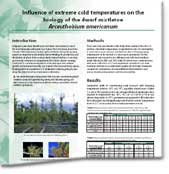|

Science > Scientific
Posters
 Scientific
Posters Scientific
Posters
The following posters were presented by NoFC researchers at the XII World
Forestry Congress in Quebec City, September 21-28, 2003.


Boreal Forest Composition and Biomass Storage
Under Changing Fire Regimes in Canada
The Stand-Level Boreal Fire Effects Model (BIOFIRE) was developed to
provide an estimate of the impact and sensitivity of carbon dynamics in
a changing fire regime.
Research Team / Author: P.M. Bothwell and W.J. de Groot
View poster
(PDF 1.60 Mb)
[top]
Carbon Accounting at the Scale of Forest Management
Operations
The Canadian Forest Service has identified a need for a carbon forest
accounting tool at the operational scale to help foresters understand
the impacts of forest management on carbon stocks. This tool is intended
to help foresters understand and evaluate the effects of forest management
applications on carbon stocks and stock changes.
Research Team / Author: W. Kurz, M. Apps, T. Schivatcheva, E. Banfield
and S. Kull
View poster
(PDF 485 kb)
[top]
Development and Application of Fire Danger Rating
in Southeast Asia
For several decades, fires and the associated haze has affected the economies,
health, and environment of countries in Southeast Asia. The CFS, in partnership
with agencies in Indonesia, Malaysia, Singapore, and Burnei converted
the Canadian Forest Fire Danger Rating System for local conditions in
these countries.
Research Team / Author: M. Brady and S. Price
View poster
(PDF 764 kb)
[top]
A Dynamic Decision Support System for Adaptive
Management
Forest resource management is a combination of natural sciences, social
sciences and economics. Adaptive management is an approach that could
be applied to forest management practices. Decision Support Systems for
implementing Adaptive Management will require the assessment of current
and future forest conditions.
Research Team / Author: C. Li and H. Hans
View poster
(PDF 277 kb)
[top]
The Ecophysiological Basis for Regeneration Silviculture
of Boreal Picea glauca
Problems with the regeneration of Picea glauca arise in a boreal
mixedwood forests due to the competition from other vegetation and cold,
wet soils. The Canadian Forest Service is trying to link the seedling
response to micro-environmental factors that silvicultural practices create.
Research Team / Author: J. Stewart, T. Jones, R. Hurdle and D. Sidders
View poster
(PDF 1.28 kb)
[top]
Influence of extreme cold temperatures on the
biology of the dwarf mistletoe Arceuthobium americanum
This study's aim is to determine the minimum winter temperature that
prevents dwarf mistletoe seeds from germinating and if exposure to late
spring frost can kill the embryo and radicle of dwarf mistletoe germinates.
Research Team / Author: J.P. Brandt, Y. Hiratsuka and D.J. Pluth
View poster
(PDF 1.46 MB)
[top]
Resource opportunities for Northern Saskatchewan
Communities Pilot Program
Natural Resources Canada has a mandate to promote sustainable development
and responsible use of our natural resources. In 2001 NRCan initiated
a pilot program to identify resource opportunities in Northern Saskatchewan
communities.
Research Team / Author: D. Boylen and M. Newman
View poster
(PDF 671 kb)
[top]
Understorey Protection as an Alternative to Clearcutting
in Boreal Mixedwoods
Trembling aspen and white spruce are an important source of wood fibre
to the forest products industry. Using conventional practices, stands
are clearcut and aspen/popular trees are allowed to regenerate by sucker
or seed. However, the remaining protected white spruce would die off due
to wind damage and harvesting conditions. In light of the situation, forest
managers are seeking innovative ways to manage and regenerate these stands.
Research Team / Author: D.A. Macisaac and R.F. Krygier
View poster
(PDF 365 kb)
[top]
Wildland Fire Behavior Research at the Northern
Forestry Centre
The Wildland fire behavior research at the Northern Forestry Centre has
two main objectives: 1) to develop mathematical models and operation guidelines
for predicting the characteristics of extreme fire behavior, and 2) to
ensure fire managers and other clients are up to date with the latest
research in wildland fire dynamics.
Research Team / Author: M. Alexander
View poster
(PDF 369 kb)
|